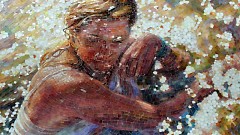
"Svelata" by Mia Tavonatti repeats solutions from 2009 winners: realism, water theme, and many pieces make the image / David Guthrie

"Svelata" by Mia Tavonatti repeats solutions from 2009 winners: realism, water theme, and many pieces make the image / David Guthrie
Writer Alfie Kohn examines the use of rewards and presents a fascinating case for how rewards often fail, especially when the desired outcome is human quality. In his book, Punished by Rewards, Kohn outlines five reasons that rewards fail. I tried out these reasons in an analysis of the conditions created in ArtPrize and was able to get a clearer image of some subtle dynamics that might be at work under the prize.
The ArtPrize Worst Tumblr created a collage with an explanation of some of the trends that have been repeated among entries and across years.
Risk-taking is recognized as essential for innovation in many fields, and in the practice of art is required for imaginative leaps, new connections, and material discoveries.
The work presented in ArtPrize is significantly more traditional in format when compared with other comprehensive displays of contemporary art, especially on an international level. There is also dramatically less experimentation in the use of spaces and contexts. This could be for many reasons - minimal curatorial and institutional support and collaboration - but it could also be a sign that the structure discourages risk-taking and shifts the conditions for art to a more safe and conservative mode. It is telling that after almost 3,000 works of art have been presented in the last two years, none have caused serious concern or controversy. This alone seems evidence that risk-taking is constrained or minimized in some significant ways. Perhaps venues even avoid selecting challenging or edgy work in an effort to appeal to what they think people will like.
ArtPrize has turned out the multitudes for a visual art event. This is a phenomenal feat that I don't quite understand. It was exciting to feel the energy of a crowd and to know people had come out to experience art. Such participation is significant because the arts are a highly potent aspect of our public sphere: a volatile and unpredictable space where we can practice and imagine ways we might think and be together. With the intense focus on material desires in the marketplace and a continuous barrage of images in the media, it is vital to have another context in which we can work out our relationships to these things and each other through rich cultural engagements in public space. Given the importance of the spatial and visual in contemporary life, I’m often surprised that there is not more regular interest in visual art.
ArtPrize is not as much a democratic model as it is a market model. The huge and scarce prize structure incentivizes many things, but it is unclear how it directly activates either capital or cultural economies of art or results in trickle down economic flows to artists or the infrastructure and culture that support their practice. If the analysis about rewards above is accurate at all, we might be constraining and contorting both artists and the art in ways that don't result in producing the most effective and dynamic results.
ArtPrize plops a new edifice into place but leaves a lot of structural backfilling if we are to be an engaged public (viewers and artists alike) who support a qualitative and relevant progression of art. Will these structures and the leadership they require develop in a thickening of cultural organization, or are we each left alone in the crowd with our long shot at the prize and our atomized vote?
The Rapidian, a program of the 501(c)3 nonprofit Community Media Center, relies on the community’s support to help cover the cost of training reporters and publishing content.
We need your help.
If each of our readers and content creators who values this community platform help support its creation and maintenance, The Rapidian can continue to educate and facilitate a conversation around issues for years to come.
Please support The Rapidian and make a contribution today.
Comments
i think you make some good points here... though i am not sure that every artist thinks the same way in this regards... i think the majority of them may be involved in these dynamics on some unconcious level... i have seen the failure of rewards based initatiaves in my manufacturing, educational and mental health experiences so i do feel that it carries some validity... though these reasons could also be fodder for some "artists" to cop out, justifying their lack of cooperation or competitiveness.
Paul, I am glad you wrote this and posted. It articulates so many of the conclusions I had come to about AP and substantiates it with concrete studies.
With great wealth comes great responsibility.
What (besides a wad of cash) is the professional benefit to winning the AP? If an Artists wins the Turner Prize it pretty much launches their career into the stratosphere. I don't think you can say the same thing about winning the AP.
I've recently concluded in a Facebook Note that I've written
http://www.facebook.com/note.php?note_id=407928732254
that I believe AP isn't really interested in Paul's question. I don't believe AP is interested in using creatives to form a new economic model, rather they have formed an entrepreneurial model that uses creatives.